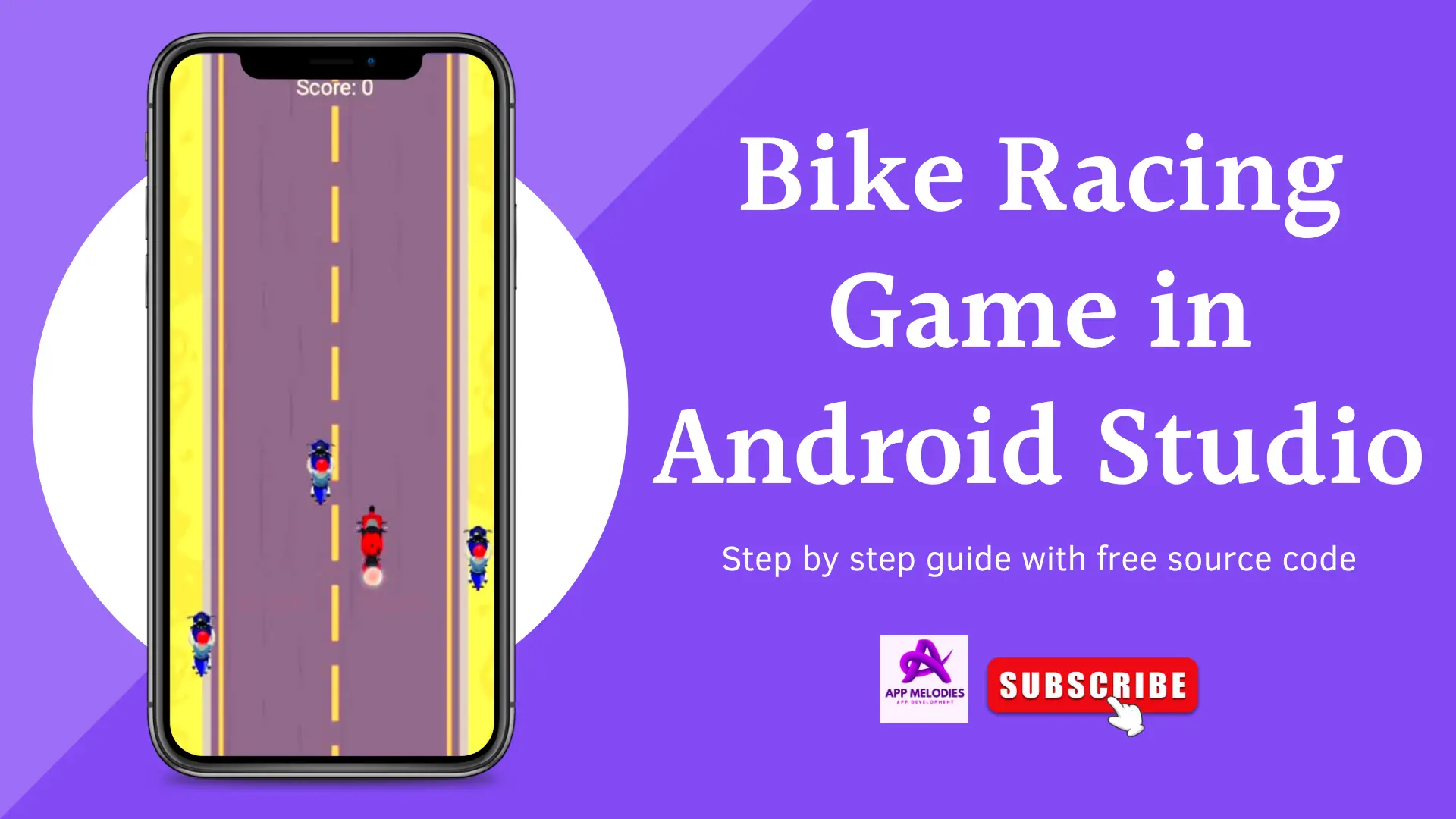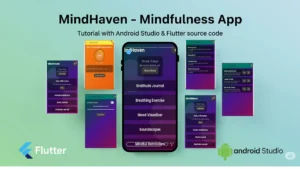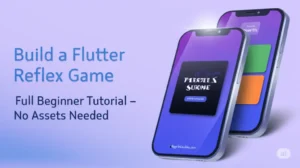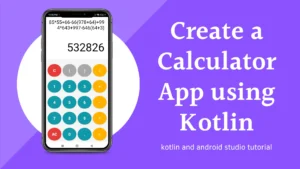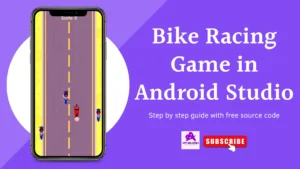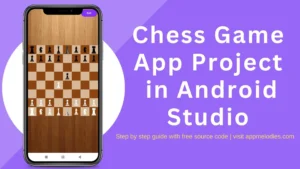Creating an interactive and engaging bike racing game in Android Studio Kotlin is a rewarding experience for developers. In this tutorial, we’ll guide you through building a simple yet dynamic 2D bike racing game in Android Studio Kotlin using source code. This guide is SEO-friendly, unique, and written to ensure a smooth learning experience.
Prerequisites
Before you start, make sure you have:
Android Studio installed on your computer.
Basic knowledge of Kotlin and Android development.
Step 1: Set Up Your Project Bike Racing Game in Android Studio
Open Android Studio and create a new project.
Select Empty Activity and click Next.
Name your project (e.g., “BikeRacingGame”) and set the language to Kotlin.
Click Finish to create your project.
Step 2: Design the Game Layout for Bike Racing Game in Android Studio
Open the
activity_main.xmlfile.Use a RelativeLayout to organize your game components. Add two
ImageViewelements for the scrolling road background and one for the player bike.Add a
TextViewto display the score and aButtonfor restarting the game.
Example activity_main.xml:
<RelativeLayout
xmlns:android="http://schemas.android.com/apk/res/android"
android:id="@+id/rootLayout"
android:layout_width="match_parent"
android:layout_height="match_parent">
<ImageView
android:id="@+id/roadBackground1"
android:layout_width="match_parent"
android:layout_height="match_parent"
android:src="@drawable/road1"
android:scaleType="fitXY" />
<ImageView
android:id="@+id/roadBackground2"
android:layout_width="match_parent"
android:layout_height="match_parent"
android:src="@drawable/road1"
android:scaleType="fitXY" />
<ImageView
android:id="@+id/playerBike"
android:layout_width="60dp"
android:layout_height="90dp"
android:src="@drawable/redbike"
android:layout_alignParentBottom="true"
android:layout_centerHorizontal="true" />
<TextView
android:id="@+id/scoreText"
android:layout_width="wrap_content"
android:layout_height="wrap_content"
android:text="Score: 0"
android:textSize="24sp"
android:textColor="@color/white"
android:layout_marginTop="20dp"
android:layout_alignParentTop="true"
android:layout_centerHorizontal="true" />
<Button
android:id="@+id/restartButton"
android:layout_width="wrap_content"
android:layout_height="wrap_content"
android:text="Restart"
android:visibility="gone"
android:layout_centerInParent="true"
android:background="@color/black"
android:textColor="@color/white" />
</RelativeLayout>
Step 3: Implement Game Logic in Kotlin
Open the
MainActivity.ktfile.Define variables for game components:
Player bike.
Road backgrounds.
Enemy bikes.
Game score and speed.
Key Code Snippets
MainActivity.kt
package com.example.myapplication
import android.annotation.SuppressLint
import android.graphics.Rect
import android.os.Bundle
import android.os.Handler
import android.view.MotionEvent
import android.widget.Button
import android.widget.ImageView
import android.widget.RelativeLayout
import android.widget.TextView
import androidx.appcompat.app.AppCompatActivity
import kotlin.random.Random
class MainActivity : AppCompatActivity() {
private lateinit var playerBike: ImageView
private lateinit var roadBackground1: ImageView
private lateinit var roadBackground2: ImageView
private lateinit var scoreText: TextView
private lateinit var restartButton: Button
private var score = 0
private val baseRoadSpeed = 15
private var dynamicRoadSpeed = baseRoadSpeed
private val handler = Handler()
private var gameRunning = true
private val enemyBikes = mutableListOf<ImageView>()
private val enemySpeeds = mutableListOf<Int>() // Individual speeds for each enemy
override fun onCreate(savedInstanceState: Bundle?) {
super.onCreate(savedInstanceState)
setContentView(R.layout.activity_main)
// Initialize views
playerBike = findViewById(R.id.playerBike)
roadBackground1 = findViewById(R.id.roadBackground1)
roadBackground2 = findViewById(R.id.roadBackground2)
scoreText = findViewById(R.id.scoreText)
restartButton = findViewById(R.id.restartButton)
playerBike.post {
playerBike.x = (resources.displayMetrics.widthPixels / 2 - playerBike.width / 2).toFloat()
}
// Start game
startNewGame()
// Restart game on button click
restartButton.setOnClickListener {
startNewGame()
}
}
private fun startNewGame() {
// Reset variables
score = 0
gameRunning = true
scoreText.text = "Score: $score"
restartButton.visibility = Button.GONE
// Reset road speed
dynamicRoadSpeed = baseRoadSpeed
// Remove old enemy bikes from the layout and clear the lists
val rootLayout = findViewById<RelativeLayout>(R.id.rootLayout)
for (enemyBike in enemyBikes) {
rootLayout.removeView(enemyBike)
}
enemyBikes.clear()
enemySpeeds.clear()
// Reset road positions
roadBackground1.y = 0f
roadBackground2.y = -resources.displayMetrics.heightPixels.toFloat()
// Create and add new enemy bikes dynamically
val numberOfEnemies = 3 // You can increase this number to add more enemies
for (i in 1..numberOfEnemies) {
val enemyBike = ImageView(this).apply {
setImageResource(R.drawable.bikeblue)
layoutParams = RelativeLayout.LayoutParams(
140, // Enemy width
200 // Enemy height
).apply {
topMargin = -200 // Start above the screen
}
x = Random.nextInt(
0,
resources.displayMetrics.widthPixels - 140 // Adjusted for new width
).toFloat()
y = -200f
}
rootLayout.addView(enemyBike) // Add to layout
enemyBikes.add(enemyBike)
enemySpeeds.add(10 + i * 2) // Varying speed for each enemy
}
playerBike.post {
playerBike.x = (resources.displayMetrics.widthPixels / 2 - playerBike.width / 2).toFloat()
}
// Start mechanics
setupScrollingBackground()
moveEnemyBikes()
setupPlayerControls()
}
private fun setupScrollingBackground() {
val runnable = object : Runnable {
override fun run() {
if (!gameRunning) return
// Move backgrounds at dynamic speed
roadBackground1.y += dynamicRoadSpeed
roadBackground2.y += dynamicRoadSpeed
// Reset positions
if (roadBackground1.y >= resources.displayMetrics.heightPixels) {
roadBackground1.y = roadBackground2.y - resources.displayMetrics.heightPixels
}
if (roadBackground2.y >= resources.displayMetrics.heightPixels) {
roadBackground2.y = roadBackground1.y - resources.displayMetrics.heightPixels
}
handler.postDelayed(this, 30)
}
}
handler.post(runnable)
}
private fun moveEnemyBikes() {
val runnable = object : Runnable {
override fun run() {
if (!gameRunning) return
for (i in enemyBikes.indices) {
val enemyBike = enemyBikes[i]
val newY = enemyBike.y + enemySpeeds[i]
if (newY > resources.displayMetrics.heightPixels) {
// Reset enemy bike position
enemyBike.y = -200f
enemyBike.x = Random.nextInt(
0,
resources.displayMetrics.widthPixels - 140
).toFloat()
// Increment score
score++
scoreText.text = "Score: $score"
// Adjust speed dynamically based on score
if (score % 1 == 0) { // Change speed every 5 points
val speedIncrement = (1 + score / 20).coerceAtMost(10) // Gradual increment
enemySpeeds[i] += speedIncrement
dynamicRoadSpeed += speedIncrement // Increase road speed slower
}
} else {
enemyBike.y = newY
}
}
checkCollisions()
handler.postDelayed(this, 30)
}
}
handler.post(runnable)
}
@SuppressLint("ClickableViewAccessibility")
private fun setupPlayerControls() {
val rootLayout = findViewById<RelativeLayout>(R.id.rootLayout)
rootLayout.setOnTouchListener { _, event ->
if (!gameRunning) return@setOnTouchListener false
when (event.action) {
MotionEvent.ACTION_MOVE -> {
// Adjust the position of the bike based on the touch
val offsetY = 200f // Offset the bike above the touch point
// Calculate the new x and y positions
var newX = event.rawX - playerBike.width / 2
var newY = event.rawY - playerBike.height / 2 - offsetY
// Clamp the position to keep the bike within screen boundaries
val screenWidth = resources.displayMetrics.widthPixels
val screenHeight = resources.displayMetrics.heightPixels
val minX = 0f
val maxX = (screenWidth - playerBike.width).toFloat()
val minY = 0f
val maxY = (screenHeight - playerBike.height).toFloat()
newX = newX.coerceIn(minX, maxX)
newY = newY.coerceIn(minY, maxY)
// Update the bike's position
playerBike.x = newX
playerBike.y = newY
}
}
true
}
}
private fun checkCollisions() {
val padding = 30 // Adjust collision area
val playerRect = Rect(
(playerBike.x + padding).toInt(),
(playerBike.y + padding).toInt(),
(playerBike.x + playerBike.width - padding).toInt(),
(playerBike.y + playerBike.height - padding).toInt()
)
for (enemyBike in enemyBikes) {
val enemyRect = Rect(
(enemyBike.x + padding).toInt(),
(enemyBike.y + padding).toInt(),
(enemyBike.x + enemyBike.width - padding).toInt(),
(enemyBike.y + enemyBike.height - padding).toInt()
)
if (Rect.intersects(playerRect, enemyRect)) {
endGame()
break
}
}
}
private fun endGame() {
gameRunning = false
handler.removeCallbacksAndMessages(null)
scoreText.text = "Game Over! Score: $score"
restartButton.visibility = Button.VISIBLE
}
override fun onDestroy() {
super.onDestroy()
handler.removeCallbacksAndMessages(null)
}
}
Step 4: Add images for Bike Racing Game in Android Studio
Download images from given link and move them to drawable folder.
Step 5: Test and Debug Bike Racing Game in Android Studio
Run the app on an emulator or physical device.
Ensure the bike moves smoothly, the score increments correctly, and the game resets properly.
Conclusion
By following this step-by-step guide, you can build a fully functional 2D bike racing game in Android Studio Kotlin using source code. Customize and enhance it further to create a unique gaming experience. Happy coding!

Build a Stunning Star Runner Flutter endless runner game in Android Studio (2-Minute Tutorial)
Build Your First Flutter Endless Runner Game: A Beginner’s Guide New to coding? Let’s create a fun Flutter endless runner


